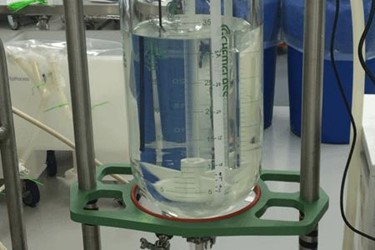Lessons From Mersana's Outsourced Model For ADCs

By Louis Garguilo, Chief Editor, Outsourced Pharma

Antibody-drug conjugates (ADCs) are on the move in the regulatory approval pipeline. Time again for us to view this technology through our prism of external support systems to see what we can further learn about our industry. Luckily, we get that view – with all its component complexity, externalized business modeling, and best practices – through the eyes of Michael Kaufman, long-time biopharma executive (Merck, Takeda, Biogen), and now Senior Vice President of CMC for Cambridge, Mass-based Mersana Therapeutics.
Kaufman explains below how Mersana’s outsourcing model places it in the hunt to add another drug – its lead candidate is for the treatment of certain breast cancers in women – to the now five ADCs approved by the FDA. That strategy and those best practices, though, are applicable to drug owners and service providers in all fields, not just the estimated 60-plus ADCs in clinical trials, and the many related technologies currently in labs around the globe. Then in a follow-up article, Kaufman will also describe how he’s teamed up Mersana with his former colleagues at Takeda’s Millennium, to assist in supply chain decisions and management.
The Complexity Challenge
 Mersana, founded in 2002 and reconstituted in 2012 to focus exclusively on ADCs, “partners” all of its development and manufacturing. “So we need to be very efficient at it,” understates Kaufman. Let’s quickly lay out the challenges.
Mersana, founded in 2002 and reconstituted in 2012 to focus exclusively on ADCs, “partners” all of its development and manufacturing. “So we need to be very efficient at it,” understates Kaufman. Let’s quickly lay out the challenges.
First comes the strategizing of the manufacture of the cytotoxin (payload) – a small molecule (or as we’ll see in a moment, molecules) made by traditional organic synthesis. That’s combined with technologic knowhow to make the drug linker, a “major part of novel ADC technology.” Next, there’s a need to become proficient with antibodies, meaning “biologics manufacturing from cell-line development through bioreactor and purification.” Finally, in the grand combination that brings the delivery system to life, the antibody and the drug linker have to unite in a bioconjugation reaction. When all of that’s done, “you get to make drug product by standard sterile technology.”
Along with the science and technology, timing and scheduling reaches new heights of criticality in this outsourced model. “You can’t make the drug substance until you have the antibody and the drug linker, and each of those has long turnaround times,” explains Kaufman. He says the lead time from getting raw materials into a supply chain to the finished product in a vial, and ready for clinical trials, is about twelve to eighteen months.
“Don’t forget the partner who works with the payload has to be expert in high potency manufacturing,” adds Kaufman. And while most players in the ADC field put three or four drugs onto their antibody, for Mersana it’s more like ten to fifteen with a single linker. “To do so,” explains Kaufman, “we need a fairly complex linker, and that comes with a price in terms of manufacturing complexity." Also unlike others in the business, Mersana’s linker is a polymeric substance. “That too causes challenges in pharmaceutical manufacturing, where polymers are a bit of an odd item.”
“Obviously,” concludes Kaufman, “we need to do a lot of planning, understand capacity and the most appropriate batch sizes, and then pull this all together. It’s the most challenging supply chain I’ve ever had to run.” The good news? “Our production schedule so far has been pretty close to what we’ve planned.” Let’s take a look at why.
Picking Partners
Mersana puts a great deal of thought into the strategy and selection of its partners. “One consideration was to have the partner who makes the cytotoxin also make the polymer, and to put these together,” says Kaufman. That critical requirement severely limited the number of manufacturers to those with the capability to handle high potency, and perform polymer, chemistry. But sometimes building a supply chain starts with these decisions.
“We wanted an integrated process at a single partner,” says Kaufman. “We had a pretty short list of potential partners, because most said, ‘No, we’re not going to bid on the project. We don’t have the technology, the capabilities, and this just doesn’t fit our model.’ I congratulate them for being honest … and it left us with about three or four serious contenders.”
What were the criteria for selecting from the remaining few? “Technologic fit was high on our list of criteria,” replies Kaufman. “And let me be honest: Price was high on the list, too. As a small company, maybe higher than for some bigger competitors.”
On the other hand, and somewhat surprising considering the complexity, geography wasn’t as important. “That’s not to say local isn’t better to some degree,” explains Kaufman, “but we were able to cast a global net.”
But serendipity at times works to a drug developer’s advantage. “The antibody and bioconjugation reaction ended up being done ten miles from the manufacturing … in a Midwest USA city with a big arch. But we also have some manufacturing going on in China, and in Europe.”
It goes without saying that quality and regulatory experience were also important criteria for Mersana when selecting partners. “Particularly as the technology gets more complicated, contracting people who can write good records – and very competently explain their work to regulatory health authorities – increases in importance,” says Kaufman.
All told, to get Mersana’s lead candidate (XMT1522) to phase one, and provide the feeling of a secure supply chain, the company currently has four manufacturing partners making components. “We also centralized an analytical testing lab, so all the samples flow into one laboratory,” adds Kaufman. And Mersana brought in a pharma partner (more on that in part two) that’s helped provide expertise in selecting service partners, and supply chain management. And management is where we turn next.
Management Not So Complex
About the only ingredients not complex in all of this are Kaufman’s keys to managing his external partners: openness and honesty.
“The openness part took a while to learn, I have to admit,” he says. “I came from Big Pharma, where it was more a culture of guarding competitive advantage; tell people as little as possible. But I’ve learned it’s pretty hard to develop drugs, and it works better when we work together. I always aim at inclusion. At the end of the day, if we can exchange information, we’ll all do better, including patients.”
Next, Kaufman says understanding that nobody is perfect, and dealing with missteps honestly on both sides, is vital to drug development in the outsourced model. “We make our mistakes as well,” he says. “We may schedule things wrong, or components aren’t available. I tell our CDMOs of the possibility something might be off-schedule as soon as possible, and expect the same in return.”
That openness includes – “Whenever it makes sense” – allowing partners to communicate and work together. “We have no problem with various people interacting with each other. To give you a specific example, this summer we wanted our Midwest bioconjugation partner – okay, its MilliporeSigma [which has been publically disclosed] – to help us solve a purification challenge. We invited them to Mersana’s laboratories in Cambridge to work with our development chemists, and we also invited Takeda to join us. It was terrific to see that degree of collaboration. That’s how you combat complexity in the supply chain.”
----------------
We’ll continue our conversation with Michael Kaufman, Senior Vice President of CMC for Cambridge, Mass-based Mersana Therapeutics, in part two.
